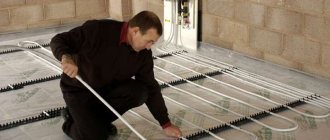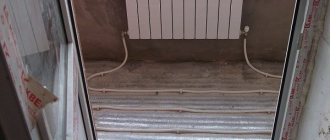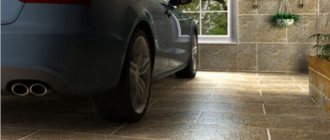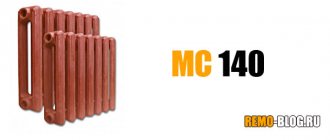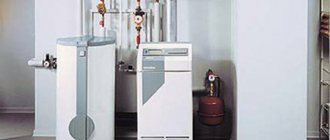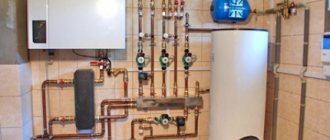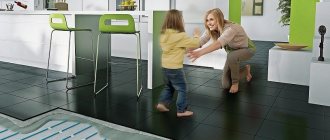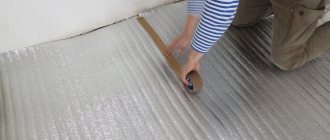Warm water floor. Installation and main features
You still doubt your choice.
Which is better, stop at radiators or start preparing the installation of heated floors. Just evaluate the amount of materials, equipment and level of work required in each individual case. This will give you immediate answers to many questions, whether to leave the heating radiators or opt for heated floors. First you need to understand what the main stages of installing heated floors are. Why start with this heating option? The thing is that this method is considered newer and little-studied for most consumers.
It is better to install warm water floors in a new building, when finishing work has not yet begun, and instead of a floor there are simple concrete floors. We take into account the fact that with water circuits laid in the floor, the ceiling height in heated rooms will decrease by 100-150 mm. For a private house this does not pose a problem, but for a city apartment it sometimes becomes critical.
The basic installation is as follows. The surface is prepared on which a layer of thermal and waterproofing is laid. Next comes a mesh or special mats on which the water pipes of the heating circuit are laid. As a result, your floor takes on the appearance of a layer cake. This design is called a layer cake, in which each layer plays its own specific role.
Before concrete wet work, a damper tape is glued around the perimeter of the room, which plays the role of a compensator for the thermal expansion of the concrete surface. The water pipe is laid according to two patterns, a snake or a spiral. Depending on the heating intensity, you choose the laying scheme yourself.
Only after connecting the water circuits to the distribution equipment (pumping and mixing unit) is a test run carried out. If no flaws are found in the technical part of the system, there are no leaks and heating is in accordance with the specified parameters, you can begin laying the concrete screed.
Underfloor heating without radiators is usually chosen when there is a powerful autonomous high-power heating boiler. In a house where constant heating is required, there is a constant consumption of hot water, heated floors must work without interruption. It is thanks to a powerful boiler that the required heating intensity of the coolant and the flow rate satisfying the technological parameters are achieved.
Features of heating with heated floors
The technology of heating underfloor heating appeared not so long ago, but is gaining more and more popularity every year. However, before installing such a system, understand everything in order to understand whether it is advisable. And in view of the fact that boilers are usually installed in private houses, attention should be paid specifically to water heated floors.
Features of a water floor system in a private house
Types of radiators
Radiators for the manufacture of heating pipelines are popularly called batteries. New models are made from different metals, which are superior in technical characteristics and aesthetics to cast iron products. Types of radiators:
- Aluminum batteries are efficient batteries that are installed in new multi-story buildings. They quickly fail if the coolant contains alkalis and acids.
- Steel - there are sectional and tubular. The level of heat transfer does not depend on the shape of the battery.
- Bimetallic ones are the most effective in heating rooms. Made from a mixture of aluminum and steel.
Any of the presented types is relevant when assembling a heating circuit with polypropylene pipes.
Heating options without batteries
Today there are several types of heated floors, each of which has its own pros and cons. The feasibility of installing each type as the main heating depends on the parameters of the room and the planned heat source.
Water floor
To operate this type of heating, you need a boiler that heats the coolant and a pump that circulates water through the pipeline. Installation of a water floor is very complicated and requires laying several layers of material (thermal insulation, reinforcing mesh, concrete screed, finishing coating). Both independent and additional heating can be used for rooms of any size, however, for large houses it will be necessary to carry out complex calculations and install one or more collectors.
Cable floor
Cable-type electric heaters occupy part of the floor area (about 70%), they are placed in places free from furniture and heavy objects. It is usually used for independent heating of small rooms or as an additional one, since heating a large house with electricity is not economically profitable.
Infrared film floor
Suitable for small and medium-sized rooms and does not require laying a cement screed, so it is advisable to install IR film not only on the floor, but also on the walls and ceiling. This type of heating can be used as the main one, provided there is a stable power supply.
Rod electric floor
A deck made of interconnected carbon rods is laid under a concrete screed or tile and provides the most effective distribution of heat emitted in the infrared range. This type can be rationally used for heating individual rooms or small spaces.
Read more about choosing a heated floor and designing the system in our articles.
Interior Design
Thanks to the hidden laying of the pipeline with the coolant, the warm floor is invisible, so it can be used to solve any design ideas. It can be installed under any floor covering, from ceramic tiles to linoleum and laminate.
Also, radiators, in this case, are inferior to a warm floor in their location, since they must be mounted on load-bearing external walls under windows and other openings, which takes up extra space and spoils the appearance. Of course, there are special decorative batteries with different patterns, but their cost is many times higher and is not economically profitable.
Specifications
Water system
Main technical characteristics of water heated floors:
- Heat dissipation. The average heat transfer of a water heated floor is 50 W/sq. m. This value was determined from many calculated values of different projects and was recognized as the most correct for average conditions. The value is 2 times less than the accepted average value of the required heat transfer for radiator systems, equal to 0.1 kW/sq. m., which indicates greater efficiency of the system and lower losses.
- Maximum coolant temperature. In this case, the value of the initial temperature is not so important, since the operating temperature of the pipes is achieved by mixing the cooled return into the direct flow. The operating temperature of the coolant is always lower than in the direct flow of the main line, otherwise the room will be very hot. The usual temperature of the mixture is around 50 degrees, due to which the temperature of the warm water floor, taking into account losses and cooling in the circuits, allows you to obtain comfortable conditions in the room.
- Working and maximum working pressure. The optimal operating pressure is considered to be 1.5-2 atm, pressure testing - 4-5 atm. It should be taken into account that the pressure test is created only in the circuit system, since its own boiler is rarely designed for pressure above 3 atm.
- Thermal power of a water heated floor. Determined by dividing the amount of heat loss by the area of the room. The problem is that the area is easy to determine, but heat loss is difficult, this involves the method of installing a heated floor, the type of coating, the type of construction, and the material of the pipes. The easiest way is to use an online calculator, which determines the thermal power using its own algorithms; you just need to enter your own data - area, pipe material, laying pitch, etc.
Radiators
Main technical characteristics of heating radiators:
- Heat dissipation. Depending on the material of the device, the amount of heat transfer varies. For example, cast iron radiators have 4 times less heat transfer than aluminum radiators and 6 times less than bimetallic radiators. Therefore, it is impossible to indicate exact numbers without reference to the size of the device, room and coolant temperature. There is an average value - 0.1 kW/sq. m., which serves to determine the required heating heat transfer for certain rooms. It is used to roughly determine the power of the device when choosing. Each device has its own heat transfer value indicated in the passport. The main thing is to clarify whether this means the general value, or for one section.
- Maximum coolant temperature. If the power is supplied from the central heating network, then established standards apply that link the temperature of the coolant with the air temperature outside. For example, at -15 degrees, the water temperature in the central heating main is 105 degrees. During transportation, it drops by some amount, but in any case, the water must withstand return transportation to avoid freezing of pipes along the route. Based on comfort considerations, the temperature of the radiators should ensure 18-20 degrees in the room (this is the established norm, for some it is cool), which depends on the size of the room, as well as the size of the radiator. At the same time, the calculated values of the maximum coolant temperatures are much higher, for example, for cast iron radiators it is assumed to be 150 degrees, for bimetallic radiators - 130 degrees, steel ones have a limit of 110-120 degrees.
- Working and maximum working pressure. The values differ slightly for devices made of different materials, on average the working pressure is 8-11 atm, the pressure test pressure is 14-16 atm. These are declared passport values, which in reality do not always correspond to such values. In the network, the operating pressure is often reduced and is about 6-7 atm, while the pressure test reaches 15 atm. It must be remembered that when powered by a central heating system, you have to use the pressure provided by the network, which requires monitoring and regulation. If the operating parameters of the radiators do not correspond to the existing values, reduction gears or diaphragms should be used.
- Thermal power. The thermal power of a heating radiator is equal to the coolant flow rate. More complex methods of determination can only confuse and complicate all calculations; it is much easier to use either passport data or the amount of coolant flow. Another option is to calculate based on the volume of the room. The heating requirement of a room is calculated by multiplying the volume of the room by 41 W (the amount of energy per 1 cubic meter of volume). That is, knowing the estimated power of the heater, you can select the appropriate one according to the parameters.
Technological aspects of choice between two heating methods
Let's start with the fact that radiators have been used as heating devices for a very long time. The practical application of this heating method has proven that the batteries are quite effective at creating a comfortable temperature in the room. In addition, we should not forget that installing a heating system in a residential building using radiators is not so difficult from a technical point of view. Today, almost every person who has the necessary knowledge and a minimum set of tools can screw a battery to the main line. The battery can be made of steel, cast iron or new composite materials (bimetal). The connection methods remain the same as many years ago: threaded connection and clamp coupling.
The safety and reliability of radiator heating is indisputable. Today, batteries can be found in almost every residential building and apartment building. These heating devices have become familiar elements of the interior of our homes. Thanks to modern materials, it was possible to improve the appearance of products and increase the heating surface. These innovations have significantly improved aesthetics and increased productivity. As for other heating methods, radiator water heating is now seriously competed by warm water floors.
Underfloor heating has become common in modern low-rise housing construction. Many owners of cottages and country houses prefer heated floors. It's up to you to install radiators or install heated floors in the room. Another thing is how justified large-scale installation work on laying a water floor will be from an economic point of view.
Another thing is that radiators in an apartment or house will cost less than heated floors, which include a lot of additional service equipment and hundreds of meters of pipes. Economically, heated floors are considered an expensive pleasure, so you should be prepared for such an event as laying water floors.
For reference: from the point of view of heating experts, heated floors are not an ideal option for heating residential premises. Not every room can be technically ready for the installation of such a complex complex as a warm water floor. For a city apartment, this option is generally excluded, since there are official prohibitions on such equipment in an apartment building.
Water heating is fundamentally different from other types of heating systems. The main working tool of the system is the coolant liquid. This can be ordinary, prepared water or chemically contained substances (antifreeze and their derivatives). Whether in the first case, with radiators, or in the second, with heated floors, installation of a heating system involves laying a whole network of pipelines.
For reference: the length of the heating circuit to supply radiators in a residential building with an area of 150 m2 is about 100 meters. In the case of underfloor heating, we are talking about a total length of water heating circuits of hundreds of meters. The thing is that the operating principle of water heating systems is the delivery of hot coolant to heating devices. In the first option, radiators will play this role; in the second option, the entire floor surface in heated rooms acts as a heating device.
You can often hear the opinion that it is better to use combined heating options. This formulation of the problem will free you from the dilemma of radiators or heated floors.
Radiators are being installed in some rooms, while in others water floor heating circuits are being installed. This option for solving the heating problem is chosen by those who want to increase the level of comfort in their home. This is usually done in old houses and city apartments, not wanting to carry out a grandiose reconstruction or not having the technological capabilities for this purpose. This method of heating gets along well in an apartment when there are radiators throughout the apartment, and water heating pipes are laid in the floor in the bathroom or children's room.
All other aspects that should be taken into account when choosing a heating system lie in the psychological plane. Comfort is the most important criterion that many consumers pay attention to today. Unlike radiators, heated floors can be arranged in such a way that you forget that your house is heated at all and that there is an entire engineering structure in the floor. Warm and comfortable temperature will always be within normal limits. The presence of automatic adjustment will relieve you of the need to control the operation of the heating complex. Heating floors open up unique opportunities for designers, creating new and original elements of the interior of residential premises.
What's better?
After reviewing the advantages and disadvantages, it remains to draw a conclusion: heated floors or radiators - which is better in the end? There is no definite answer; each specific house needs its own heating system. It is not possible to obtain permission to connect a heated floor to central heating in every room; for example, installation in city apartments is an almost impossible task.
Therefore, not everyone is suitable for underfloor heating as their main heating system. But if this is possible, it is recommended to choose a water floor as the main heating system. It is more economical and easier to adapt to the arrangement of furniture in the apartment.
If completely abandoning centralized heating is not your option, but you cannot give it preference when choosing “warm floors or radiators,” there is also a way out. Many people combine the two types of systems. Minimal, but pleasant floor heating on cold days will make the house much more comfortable. Also, additional heating may be needed in the bathroom or on the loggia.
In this case, it is recommended to give preference to electric floors, as they provide more uniform heat transfer. You can find various pipe laying schemes, in some of them water circulates with optimal heat distribution over the floor covering, but this is also an additional expense. Combined heating, containing radiators plus underfloor heating, will provide a comfortable temperature level in the house.
To summarize, we can only note once again that each type of heating has its own advantages and disadvantages. Each home requires an individual approach, there is no universal advice, and the choice is only ours. But there is no need to delay the decision too much, especially in the cold season. You can trust utility companies, but shouldn’t you play it safe and get an autonomous heating source?
Heating system installation cost
If we talk about the price for installing all elements of the heating circuit in various rooms, the installation of radiators will cost the owner of a private house the cheapest:
- the batteries are hung on special mounts in the walls, and a tube supplying hot water is connected to them;
- installation of a “warm floor” involves pouring a full screed and covering the concrete floor with the finishing material.
The most difficult heating system to install is a water-based “warm floor”.
Advantages and features of heated floors
It is worth considering the superiority of a relatively new underfloor heating system. Naturally, there are many positive aspects, otherwise such floors would not have gained such popularity, which is also growing rapidly.
A question of saving. The temperature of underfloor heating systems is lower than that of radiator heaters because they occupy a smaller area. And you should know from school that heating water from 40 to 50 °C will require less energy than heating water with the same step, but from 60 to 70 °C.
Let's take this into account for the future. Further, savings are obtained due to the air heating process itself. Due to natural physical processes, air circulates throughout the room, resulting in a distribution of flows; near the floor the temperature remains at 26-30 °C, and in the upper layers it is slightly lower, at 22-24 °C. And only near the ceiling, where temperature indicators are not so important, it is 18 ° C.
These figures are quite comfortable for the average person. This may seem like an ideal temperature distribution, but there are some nuances. This point makes it possible to better understand what is cheaper – warm floors or radiators.
Heating a room using batteries has a slightly different temperature distribution. The batteries heat the air directly in the space around them, somewhere up to 50 °C, after which it rises to the ceiling and cools to 40-45 °C - it is replaced in the lower layers by cold currents, and so on in a circle. The result is ineffective heating of the room, and we have to walk on a cold floor, the temperature of which usually does not exceed 16-18 oC.
In addition, residents with such heating feel much more comfortable. And this is not surprising, because it is much more pleasant to walk on a warm floor than to try to hide your feet under something warm at every opportunity during the cold season. Although, as with any discussion, there are skeptics, who in this case believe that heated floors are ineffective and do not bring anything useful to humans, but only harm, reducing immunity and causing frequent colds and even vascular diseases. At the moment, such a dispute remains unresolved.
Currently, underfloor heating systems have been significantly improved; they are equipped with automation that allows you to regulate temperature indicators. In this case, you can configure the heating temperature control separately for each room in automatic mode.
Technological aspects of choice: advantages and disadvantages
In order to finally and correctly decide on the choice between heated floors or radiators in a private home, you should understand the advantages and disadvantages of each of the options under consideration.
Warm floor
Such systems for heating rooms for various purposes began to be used recently, but they have already become quite popular among consumers. But before you start installing such a system in a private home, it is recommended to figure out for yourself whether it can justify itself. Due to the fact that heating boilers are installed in private homes, it would be more advisable to consider the heating option using a water-based floor heating system.
Structurally, it consists of pipes laid under floor coverings. The rooms are heated using a coolant that circulates through a closed pipe system. Laying can be done in various ways, each of which effectively affects the performance of the system in certain operating conditions.
The heating system circuit can be laid in different ways:
- snake - the turns are arranged in a zigzag pattern;
- snail - pipes are laid out in a spiral.
According to experienced specialists, the second installation option gives better heating results
With this method, an important feature is compliance with the laying step, which is determined taking into account the required heating intensity
Reducing the distance between adjacent turns should be done near external walls and window openings, while increasing the step is allowed closer to the center of the room.
When making a choice between water heated floors or radiators, you should know that the first option will allow you to rationally distribute the temperature regime of the air masses. The floor over its entire surface will warm up evenly, the maximum value will not exceed twenty-six degrees Celsius, which will make it possible to feel comfortable. At the level of human height, the heat regime will drop to twenty-two degrees, and the coolest air masses will be pushed towards the ceiling
Taking into account the fact that the majority of thermal energy from the system is transferred not by convection, but by radiation, dust located on the surface of the floor and furniture will not rise up
When installing such a heating system, there is no need to take into account the design of the structure in the overall interior solution, because all communications will be hidden under the finishing of the floor.
There is one more advantage between heating a house with heated floors or radiators - during the hot season, the system performs cooling functions, so installing air conditioners is not required.
Radiators
To finally decide which is better, warm floors or radiators, it is necessary to consider this heating option. Radiators are connected in three ways, each of which has certain features:
- lateral – the supply and return connections are made on one side of the radiator. If the pipes are swapped, the heat transfer efficiency will decrease by about seven percent;
- diagonal - the supply is supplied to the top of the radiator, and the return is discharged from the opposite lower side. This option is considered the most profitable in terms of thermal output;
- lower - used in both single-pipe and two-pipe connection options. Experienced craftsmen believe that this method is the least effective.
Lateral connection of the radiator
By the way, heating radiators can be connected in two ways. In the case of installing a single-pipe version, they are installed sequentially, and at the same time materials are consumed in a minimum amount. A pipe coming from the heating boiler is laid under the radiators. Conducted through each room, it returns to the heating device. Radiators are connected to the pipe using lower pipes. The coolant that fills the radiator sections and transfers thermal energy to them descends to the lower part and is discharged through the second pipe into the pipe. The disadvantage of this scheme is that it is characterized by a low level of thermal output, since the water that has passed through one radiator approaches the next one already cooled down. This heating system is not economical, because in distant rooms the radiators will be cold.
A two-pipe system involves two pipe circuits - the supply of coolant and its removal. This feature allows heat to be distributed evenly throughout the entire object. In this case, heating with radiators over heating with heated floors has certain advantages, because it becomes possible to set the required temperature in each room. When performing repairs, there is no need to turn off the heating system completely.
Since heated air moves upward, its temperature reading near the radiators and near the ceiling will be maximum. Simply put, places will warm up, especially those that don’t need it. But the floor covering will warm up to only eighteen degrees Celsius, and not many owners of private houses consider this mode comfortable for their feet. It turns out that the radiators of the heating system do not distribute thermal energy very rationally.
It is worth noting that the convection principle of operation of most radiators helps to raise dust when air flows circulate
In addition, in the overall interior of the room it is necessary to take into account not only the dimensional parameters of the batteries, but also their external data
Continuing to discuss which is better - warm floors or radiators, it is necessary to add that installing radiators implies an accurate calculation of the required number of sections in each device. The efficiency of thermal transfer will depend on this.
Connection diagrams for heating radiators
There are only 3 such schemes, each of them has its own characteristics, pros and cons.
Diagonal connection from 12 radiator sections
Option #1. Single-pipe
Here the radiators are connected in series, making installation much easier and requiring much less consumables. A pipe running under the radiators goes from the boiler through all the rooms and returns to it. The radiators are connected via lower pipes. The liquid fills the sections of the batteries, giving them heat, falls and goes through another pipe into the same pipe.
Video - Advantages of single-pipe heating systems
As for the disadvantages of the scheme, these include, first of all, rather low heat transfer, because the coolant in this case enters each battery after it has already cooled down. As a result, the further the room is from the boiler, the colder it will be.
Option #2. Two-pipe
There are 2 pipe circuits here at once - through one the coolant is supplied to the radiators, and through the other it is removed, due to which the thermal energy is distributed evenly throughout the house.
Note! This scheme has many advantages, since each individual room can provide its own temperature regime. And if repairs are required, there is no need to turn off the entire heating system. In a word, the scheme is much better than the one described above.
Video - Connecting radiators in a two-pipe system
About methods of connecting pipes to radiators
How effective such heating will be largely depends on the way the batteries are connected to the pipeline. There are several of these methods; let’s look at the features of each of them.
Table. How batteries are connected to heating pipes.
| Connection method | Short description |
| Lateral | The supply and return are connected on one side of the heating device (top and bottom, respectively; you can swap them, but the heating efficiency in this case will decrease by approximately 7 percent). |
| Lower | Can be used in both one- and two-pipe systems. Experts believe that this is the most ineffective method. |
| Diagonal | The supply is connected from above on one side, and the “return” from below on the other. The best method if we consider it from the point of view of heat transfer efficiency. |
How to connect a radiator to pipes
A few more words about radiator heating
Due to the fact that heated air rises upward due to the laws of physics, the air temperature near the ceiling and next to the radiators can be quite high. In other words, heating will occur in areas that do not really need to be heated. But the floor temperature in this case will be only 16-17 degrees, that is, not the most comfortable for the feet. We conclude: with radiator heating, heat is distributed irrationally.
Operating principle of radiator heating
The air that passes through the batteries is warmed up and distributed throughout the room. Simply put, it circulates, and dust rises with it.
On a note! For radiator heating, it is very important to correctly calculate the number of sections for each device. After all, each section can heat only a limited area and the efficiency of the entire system depends on the number of sections in the batteries.
Video - Arrangement of a radiator heating system
Which system is more economical?
When it comes to the cost-effectiveness of underfloor heating or radiators, we will give the well-deserved victory to underfloor heating. (note: We are talking about solid systems). In practice, they are 30%-50% more economical. And that's why:
- Warm floors work on the principle of radiation and transfer heat from bottom to top. The effective working height for heating a heated floor is 200-220 cm. Simply put, we heat the space that we exactly need. Due to this, warm floors are more efficient than radiators
- Warm floor - low temperature system. And the coolant temperature is only 45 degrees. Radiators, in turn, need to be heated to 70 degrees. Here we definitely win in the process of initial heating of the coolant.
- The inertia of heated floors is greater than that of radiators.
Unlike floors, heating radiators first warm up the ceiling, then hot air flows fall to the floor. It turns out that the most effective heating is on the ceiling. And this is not entirely economical.
If the system is made by gravity, with natural circulation and cast iron radiators are installed, then the volume of coolant can reach up to one ton. Such luxury is not permissible now. Especially when energy prices are constantly rising.
What is a radiator and underfloor heating?
Radiators, or as we used to call them, batteries, are heating heat distribution devices that are installed on a wall or floor and operate on the principle of convection and only partially on the principle of radiation.
Warm floor is a heating heat distribution system that is laid under the floor surface, therefore, the heat supply comes from below. If in radiators the main principle of heat distribution in a room is convection and the auxiliary principle is radiation, then in a “warm floor” it’s the other way around, the main principle is radiation and the auxiliary one is convection.
Which heating is better: warm water floor or radiators
Which is better: warm water floor or radiators?
In most cases, the choice of heating system is between water heated floors or radiators. In order to decide, it is enough to compare both options according to several key characteristics, which will allow you to evaluate all the possibilities, pros and cons of the technologies.
Economical
This is one of the most important issues, which in the future will determine the amount of annual/monthly heating costs. If we compare both options for the distribution of hot air flows in the room, it turns out that the greatest heat from the battery remains next to it. Heating from the heated floor occurs throughout the entire area of the room.
Batteries are always installed under a window to avoid intense condensation. But this same decision causes intense heat loss to occur in the same zone. In addition, if the walls are insufficiently insulated due to the high temperature difference, the situation is aggravated.
Also, the efficiency of using a heated floor is increased due to the fact that during its operation the concrete slab is heated, which becomes a powerful source of heat, and the radiator can only act on the nearby air. As a result, savings when using heated floors average up to 30%.
Which is cheaper: water heated floors or radiators?
In this case, much depends on the area of the premises and the installed equipment. But due to the large amount of work involved in installing concrete screeds, hidden laying of pipelines, and the need to attract specialized specialists to perform such tasks, the cost of equipment and its installation when using a radiator system will be lower.
Inertia
The rate at which the room heats up when the heating is turned on is an important issue that largely determines the degree of comfort in using the system. In this case, deciding whether a warm water floor or radiators is better will not be easy. The peculiarity of the first option is that, for objective reasons, it will take longer to heat up a concrete slab than a radiator exposed to air. But at the same time, cooling when the heating is turned off using a heated floor will occur much more slowly. In this regard, the decision about whether this is a plus or a minus of water heated floors can only be made by the user himself.
Maintainability
The main problem in this case becomes the issue of accessibility of installed equipment and pipelines. For water heated floors, this is a minus, but at the same time, provided that the equipment is properly selected and the system is correctly designed and installed, the service life of hidden heating without the need for repairs will be equal to the service life of the pipes. That is, on average, you won’t have to open the screed for about 50 years. Equipment based on radiators is always open to access, but at the same time it requires repairs much more often.
There are many arguments in favor of each option, but the optimal solution in most cases is to use a combined system using both technologies. At the same time, all the pros and cons of warm water floors and radiators will be taken into account and used so that in the end the project will only benefit from their joint use.
HelpfulUseless
The main advantages of heated floors over radiators
The most popular types of underfloor heating are electric and water. The first type is a heating cable, which is fixed either on a special mesh base - a mat, or is laid independently in any configuration (snake or snail). Its installation is noticeably easier than installation of a water one, which is assembled from liquid tubes, a pump and a manifold group. Such a system requires a significant increase in the height of the base; it is worth installing it in a house where there is a boiler that runs on solid fuel - wood or coal. In other cases, it is more profitable to choose the electric option.
Let us note the main advantages of underfloor heating, which sets it apart from radiators:
- As already mentioned, the most important advantage is the benefits for the body and effective temperature control , when “your feet are warm and your head is cold!”;
- Comfort. Nothing creates an atmosphere of comfort and coziness in the house like the warmth that warms your feet from below. When you don’t need to lay out carpets, wear slippers, and you can just walk barefoot on the tiles, as if on a Mediterranean sandy beach!;
- Saving. Expert calculations have shown that when installing water heated floors, due to effective temperature distribution, a similar effect is created with less energy consumption as with batteries that consume more resources;
- Aesthetic appearance. Warm floors are hidden under the screed and do not spoil the appearance of the interior, as do rough cast iron or steel radiators of Soviet design;
- Does not accumulate dust. This feature is important for the health of all family members, especially if there are allergy sufferers in the house. Nothing accumulates dust better than batteries with complex patterns. There you can always find long-term deposits of dust that are difficult to wipe off and at the same time their particles constantly fly in the air and settle on our lungs;
- Optimal air humidity. When heating with heated floors without radiators, there will be high air humidity in the house. And, conversely, with intensive heating by radiator batteries, the air will be dry and harmful to the skin and the general condition of the body;
- Convenient and quick installation of electric heated floors. Heating mats for heated floors and infrared film are very convenient materials for installation. You can install them in literally 1 day. On the same day (infrared floor) or after 3-5 days (heating mats), the warm floor can be turned on and fully heated the room.
Disadvantages of water heated floors
- Slow heating. Warm floors are a system designed to quickly provide thermal comfort in a room. Warm floors must best meet the needs of users, be effective and controllable. However, heated floors often do not meet household expectations.
In order to visualize the entire process of operation of heat-intensive water heated floors, they can be compared to a heavy truck that has a low-power engine and worn brake pads. Such a car accelerates slowly and also slows down. Roughly the same thing happens with water-based floors: when home owners require warm floors, they take a long time to heat up, and when they are heated up, this need may no longer exist. Due to temperature changes or because night fell and the household went to bed.
- Raising the floor level. In modern construction, they began to use the technology of laying a pipeline for heated floors directly into the floor slab itself. As a rule, marketers argue that in this way the customer immediately receives ready-made heated floors. At the same time, they do not need to be leveled; just finishing is enough. However, in practice, it happens differently when finishers start finishing floors; as a rule, they are unable to level the floors under such conditions. Therefore, they still have to lay additional screed, which entails a change in the designed height of the floors. This complicates the installation of interior doors, especially critical for a two-story house.
- Frequent installation errors. Another nuance is when underfloor heating pipes are attached to the backfill fittings of the floors of the house. Such installation quite often became the cause of rapid wear and holes in the underfloor heating pipeline. Therefore, when laying warm floors in this way, it is necessary to ensure that cushioning material is laid between the fittings and the floor pipes.
In addition, often in the process of further renovation of rooms, the owners forget to draw a diagram of the installation of heated floors and hastily begin to install elements such as a bar counter. As a result, holes are drilled in the floor, which damages the coolant.
- Not all boilers are suitable. You should also pay attention to the fact that not all heating boilers can work with low-temperature coolants that are used in heated floors. This primarily applies to convection-type heating boilers. They cannot work with this type of coolant, so their automation is constantly activated to turn the boiler on and off. Of course, this leads to disruption of the normal operation of the boiler, which can cause its rapid failure.
- Limited heat dissipation. Using only warm floors as a source of heating, home owners will inevitably face a situation where, when severe frost sets in, they will not be able to cope with heating the room. Therefore, heated floors will be forced to operate at maximum temperatures, which will also lead to their rapid overheating and failure.
Disadvantages of electric heated floors
If we compare electric heated floors in relation to radiator batteries, we can highlight several additional disadvantages:
- Relative fragility. It is believed that high-quality cable-based electric heated floors last about 20-30 years. If you buy Chinese fakes or heated floors from famous brands at first glance, but also made in cheap Chinese factories, then the service life of such floors will be 1-5 years. This depends on the quality of the internal and external insulation of the cable, the material of the heating core, as well as on the reliability of the connecting couplings. From experience we can say that approximately 70% of all heated floors in Belarus are made in China.
- High cost of electricity. If we compare heating with radiator batteries from gas or solid fuel, then their cost will be 2-3 times cheaper than from electricity. This fact significantly influences consumer choice.
- They are afraid of overheating. For electric heated floors, unlike aluminum, steel or cast iron radiators, locking under furniture or materials that conduct heat poorly is critical. If you cover such a warm floor with a good Persian carpet or place a cabinet on it, then with a high probability you can predict its failure.
- Difficulty of repair. If the electrical cable floor is faulty, then to fix it you need special equipment (a thermal imager), as well as a master specialist who will pinpoint the burnt out section, remove the tiles and screed and repair the cable. Then you need to fill it again with screed and place the tile on top. Often this is all expensive and requires a lot of dirty work.
- Dependence on electricity. Electric floors, like water (pump) floors, depend on the supply of electricity. If the electricity is temporarily turned off, the house can freeze significantly in very cold weather.
A brief comparison of radiator heating and underfloor heating systems
| Heating radiators | Water heated floor | |
| Cost of setting up the system | cheaper labor and materials | more expensive labor and materials |
| Economical operation | less economical | 10 - 20% per season |
| Requirements for floor finishing materials | you can use any materials | there are restrictions, it is preferable to use ceramic tiles |
| Difficulty in carrying out repairs | repair and modernization of the system is possible | no repair possible |
| Inertia of the heating system | low | high |
| Impact on microclimate | warmer air is at the top of the room | there is warmer air at the bottom of the room, your feet are always warm |
| Influence on the interior | the appearance of devices is constantly improving, there are separate types of radiator designs | the absence of radiators expands some possibilities |
| Effect on the human body | there are practically no differences | there are practically no differences |
Indoor microclimate support
If we talk about modern heating circuits, on which it is possible to set the exact temperature, we can say that “warm floors” and radiators maintain an optimal microclimate in living spaces when they are properly configured. However, it feels like heaters installed in screeds are more comfortable and do not dry out the air like radiators.
As for the impact of any of the heating systems on the finishing materials in the rooms, the human body, there is no significant harm observed. Warm floors and radiators are safe and cannot have a negative effect on the human body.
Types of structures
Depending on the material used for the production of radiators, several types of devices can be distinguished.
- Aluminum and cast iron. These are perhaps the “oldest” versions of radiators, which were first presented to consumers at the beginning of the last century. However, it is quite difficult to find floor products made of these metals; conventional batteries are much more common, which are simply attached to the floor using brackets. We can say that these are ordinary wall-mounted models that are simply attached to the floor.
- Bimetallic radiators. This type of heating devices includes those made of two metals; aluminum-copper and aluminum-steel are more common. The features of such radiators include the following point: the water inside them moves along a special core made of steel and characterized by high corrosion resistance.
- Steel. This version of radiators is quite widespread; convectors, registers and tubular models are made from this alloy. Convectors are characterized by the same design as their counterparts made of aluminum and copper, however, with the same dimensions, the degree of heat transfer of steel models is slightly lower.
Tubular modifications can have a wide variety of configurations, due to this they are often used not only for effective heating, but also as a decorative element in the room, a stylish accent of a modern interior. The registers look like the most basic homemade installations, they are produced quite quickly: thick pipes are simply connected to each other using special jumpers, which forms a closed circuit at the output. Such products can be used as an element of the heating system or autonomously.
Separately, you need to dwell on the types of heaters inside floor radiators.
Depending on the principle of operation, they are divided into electric and water.
- The first varieties work due to a special closed heating element on which metal plates are held; they can be copper or steel. The purpose of such discs is to maximize the surface area in contact with the air flow. Such radiators are characterized by a high degree of safety, since they are equipped with fuses for effective and reliable protection against any possible malfunctions in the electrical network.
- The operating principle of water models is slightly different. The main heating element here consists of metal pipes with several plates, which are attached to a centralized heating network using special pipes.
Depending on the type of model, a floor radiator may include a fan, this significantly increases the heat transfer of the device. Such a radiator operates from an electric current network and is supplemented with special vibration-proof supports, which greatly reduce the level of noise emitted.
For owners of non-standard rooms, radiators of a wide variety of shapes and the required radius of curvature can be manufactured according to individual projects. If you plan to use the device in homes with high humidity levels, then you should give preference to models made of stainless materials with a built-in drain for drainage. Some models have special electronic regulators that allow you to set the optimal temperature background. As a rule, a remote control is included with such products.


